Every construction project has a timeline and built-in logic that determines the sequence of events or activities. Think of this timeline as a sort of riddle that must be solved. Depending on the complexity and size of the project, a CPM schedule is warranted to represent what the scheduler proposes to be the prospective timeline. For smaller and simpler projects a schedule may not be required, or even necessary. Properly documented specification manuals will iterate a project’s scheduling requirements in Section 01.
The integrity of project schedules that one sees varies considerably. Some contractors generate a schedule only because they are required to. They may keep on file one or two-year schedules that they simply redate and rename for each project. Or they issue a bare-bones baseline, and slog their way through the updates. I believe they do this a) to cut costs, and b) because they simply aren’t able to generate a proper schedule (they give up). I routinely am asked to “clean” rejected baselines in which the logic has clearly deprecated with each update. The work is time consuming and tedious. The way to obviate the need to re-baseline a schedule is to prepare a proper one in the first place.
It is clear that when general contractors issue half-cocked schedules for approval, they do so because they have no intention to use the schedule as the actual timeline. In other words, the schedule is issued as a courtesy, which is far short of its intended purpose of a blueprint of the building sequences. Why is this circumstance so persistent? In part, because the paucity of properly trained schedulers translates to industry wide incompetence, and because most contractors are unwilling to make sufficient investments in their schedules(r). Historically, this incompetence has been often expected, and even tolerated, but that’s beginning to change.
Owners are becoming savvier. Sophisticated owners and construction managers with aggressive schedules are paying more attention, and beginning to demand accountability from their general contractors. They are becoming less tolerant, and more scrutinizing, of the schedules they review. This is good news for the industry, but also presents the quandary of the dearth of skilled schedulers. I believe the recent plethora of egregiously delayed mega-projects – Big Dig (Boston), East Side Access, New York, and others, has generated more attention and awareness in the industry to delays and their costs.
It is the complexity of a project that induces a general contractor to either prepare a schedule in-house, or outsource the work. General contractors will approach scheduling requirements in a number of ways, depending on their company structure. Many larger firms have their own schedulers. Others outsource their scheduling needs. More often than not, it is the mid-sized general contractor’s project manager who ends up preparing the schedule.
The advantage to a project manager preparing a project schedule in-house is that no one is (or should be) better suited to determine the needs and requirements of each respective project. However; project managers –if they are not trained schedulers, tend to be limited in their ability to program complex schedules. That’s why savvy general contractors have their project managers prepare rough schedule outlines that they will issue to their scheduling consultant. Together, with input from subcontractors and vendors, the project manager and scheduler join forces and build a comprehensive schedule.
I emphasize the team approach to scheduling. Contractors who don’t know any better will expect the scheduler to develop his timeline independently, or in a vacuum. This is a great handicap to the overall effort, because input from the entire project-team is necessary to build a comprehensive schedule. Otherwise, the scheduler must second-guess what the other players’ intentions are. More often than not, this means going back and rebaselining – a tedious and time consuming proposition.
The following table represents the diverse contributions each player makes to the team:
On a perfect day, team members chime in with all of their back-up, so the scheduler can fold their information into his work. Naturally, perfect days are rare, and the tendency is that a scheduler will have to – in at least some measure, guess at what criteria he will receive from his team-mates, and have them vet it at some later time.
On a perfect day, team members chime in with all of their back-up, so the scheduler can fold their information into his work. Naturally, perfect days are rare, and the tendency is that a scheduler will have to – in at least some measure, guess at what criteria he will receive from his team-mates, and have them vet it at some later time.
This happens sometimes because
- the scheduler did not request the information from the team
- not all the vendors or trades may have been procured
- team-members may be unresponsive, or unable to contribute useful input
Contractors should realize and appreciate the benefits of what properly drafted schedules can do for them:
- they provide a vehicle of accountability for delay claims
- they can be used for their intended purpose – not just to mollify the architect
- they provide a layer of monitoring and control that enables the contractor to plan ahead, forecast delays, and create pro-active (before the delay) recovery schedules
In the world of litigation, a properly executed tracked baseline schedule is used to substantiate and support a delay claim. If the baseline has errors or omissions, it will not correctly represent and quantify the timeline of a given delay. If it does not, it will not be accepted as compelling evidence to a judge or jury. That is why so few contractor delay claims are honored. Even if there was a legitimate delay, if the project logic is flawed, the delay cannot be accurately quantified.
Thus accountability and control are the rewards of a properly executed schedule. Serious projects require, and merit serious schedules. Why leave these critical responsibilities to a project manager with little time, and less practical scheduling experience to prepare the schedule, when you can find a seasoned professional to do the work? I can’t think of a single reason.











